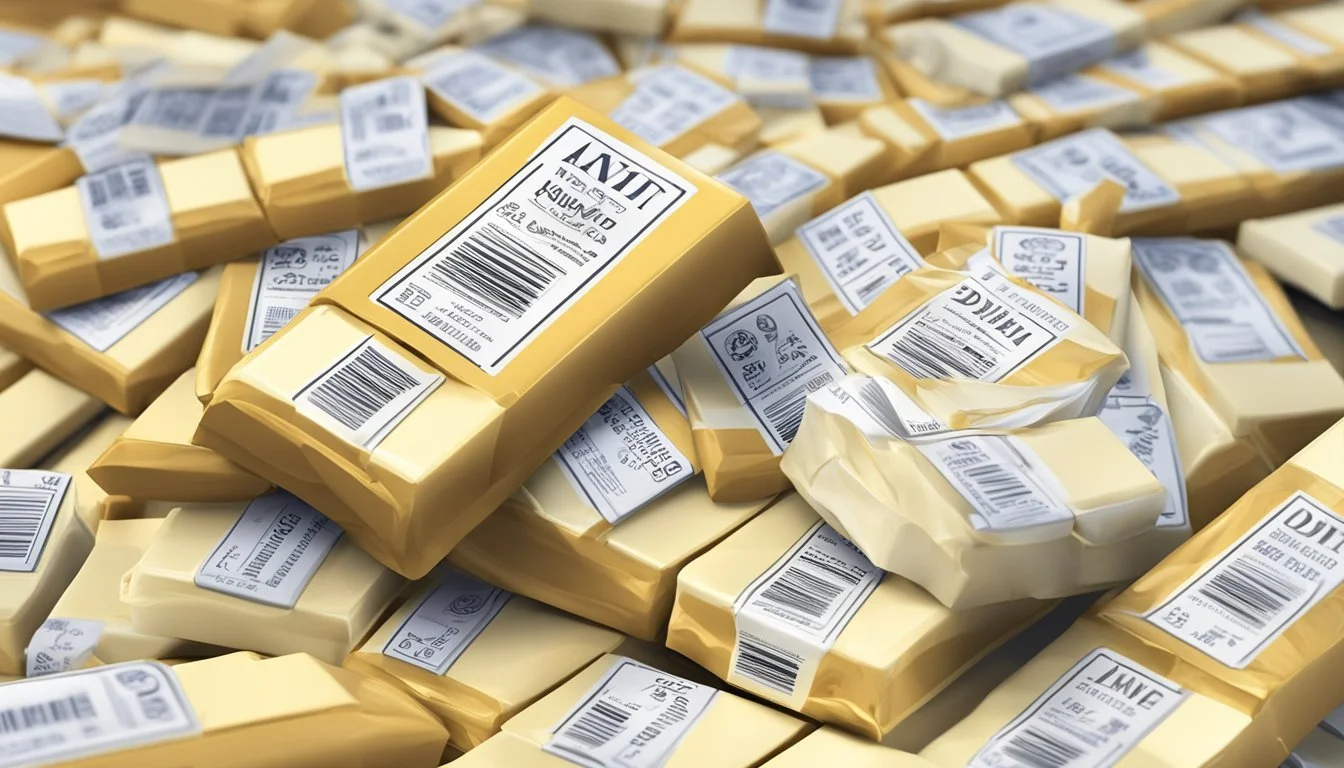How Much Lindt White Chocolate Per Day Is Too Much?
Understanding Healthy Limits
White chocolate (What wine goes well with chocolate?), a sweet treat cherished by many, has been the subject of various dietary discussions. Unlike its dark chocolate counterparts, white chocolate lacks cocoa solids and is made from a blend of cocoa butter, sugar, and milk derivatives. As a confectionery, it is often higher in sugar and fat content, necessitating moderation to maintain a healthy lifestyle. The Swiss chocolatier Lindt offers a range of white chocolate products, famed for their creamy texture and quality.
Daily consumption of white chocolate should be considered in the context of an individual's overall dietary needs and health goals. While there are no strict guidelines on how much white chocolate one should consume, it is generally recommended to enjoy it as an occasional indulgence rather than a daily dietary staple. Balancing the desire for sweetness with the daily value recommendations for sugar and fat intake is crucial for sustaining a balanced diet.
Lindt white chocolate, like other confectionery delights, can contribute to exceeding the recommended daily intake of sugars if not consumed in moderation. Consumers should be mindful of their own nutritional needs and consult with health professionals if they have specific dietary concerns or conditions that would be impacted by sugar and fat consumption. Noting that moderation and balance are key, indulgence in Lindt's white chocolate can be part of a well-rounded diet when enjoyed responsibly.
White Chocolate Composition
White chocolate's composition primarily includes cocoa butter, dairy, and sweeteners. It lacks the cocoa solids found in milk and dark chocolate varieties. Understanding its composition is essential for gauging how much can be consumed daily without exceeding nutritional recommendations.
Main Ingredients
White chocolate typically contains the following main ingredients:
Cocoa butter: The fat extracted from cocoa beans, which provides the chocolate with its smooth texture.
Milk products: These can include skim milk, whole milk powder, and sometimes condensed milk, contributing to the creamy flavor.
Sugar: Added for sweetness, significantly influencing the caloric content.
Nutritional Profile
The nutritional profile of Lindt white chocolate per serving, as indicated by nutritional data, includes:
Calories: Approximately 160-230 calories.
Fat: Can vary but is often around 13g with 9g being saturated fat.
Protein: Generally about 2g.
Carbs: Usually in the range of 16g.
Caloric Content
The caloric content of white chocolate is relatively high due to its constituents, with a standard serving containing:
Calories: Ranges from 160 to 230 calories per serving, with variations depending on the specific product and serving size.
Daily Value Percentage: Considering a daily diet of 2,000 calories, a serving can represent between 8-11.5% of an individual’s recommended daily intake.
Health Implications of White Chocolate
Consuming white chocolate can have several health implications due to its sugar and fat content. It is particularly important to consider these factors when determining how much white chocolate one should consume, as excessive intake can affect heart health and blood pressure.
Sugar and Fat Content
White chocolate typically contains higher levels of sugar and fat compared to dark chocolate. For instance, there is approximately 14g of sugar per 28 grams (1 ounce) of white chocolate. This is significant given that excess sugar intake is linked to various negative health outcomes such as weight gain and an increased risk for type 2 diabetes.
Sugar: Excessive consumption may lead to an increased risk of health issues.
Fat: White chocolate also has a high fat content, contributing to its calorie density.
Saturated Fat and Cholesterol
The cocoa butter in white chocolate results in high levels of saturated fat. Diets high in saturated fats are known to increase cholesterol levels in the bloodstream. Elevated cholesterol levels are associated with a greater risk of developing heart disease.
Saturated Fat: Essential to monitor intake to manage cholesterol levels.
Cholesterol: High cholesterol can lead to cardiovascular complications.
Impact on Blood Pressure and Heart Health
While dark chocolate contains flavonoids that may have a positive effect on blood pressure and heart health, white chocolate lacks these compounds. Consequently, white chocolate does not provide these cardiovascular benefits. In fact, due to its high sugar and fat content, excessive consumption could negatively impact blood pressure and contribute to the development of heart disease.
Blood Pressure: Lack of heart-healthy flavonoids in white chocolate means no beneficial impact on blood pressure.
Heart Health: Overconsumption may lead to adverse effects on heart health due to high sugar and fat content.
Daily White Chocolate Consumption
In assessing the ideal consumption of Lindt white chocolate, it is crucial to consider recommended intake limits and the significance of moderation. Serving sizes also play a pivotal role in determining how much should be consumed.
Recommended Limits
Health authorities often suggest that discretionary calorie intake, which includes treats like white chocolate, should not exceed a small portion of a person's overall caloric intake for the day. For instance, Lindt white chocolate, according to nutritional analyses, has high caloric content. This suggests that indulgence should be kept to a minimum to avoid excessive calorie consumption. Particularly, women and men are recommended to limit added sugars to 100 calories (25 grams) and 150 calories (37 grams) per day, respectively.
Serving Size and Moderation
When enjoying Lindt white chocolate, serving size is a practical consideration. A single serving size could typically range from 1 ounce (28 grams) to 1.4 ounces (40 grams), with each ounce harboring around 160 to 230 calories, depending on specific product formulations. The keys to enjoying white chocolate while maintaining a balanced diet are:
Understanding serving sizes: Always check the label for the proper serving size.
Practicing moderation: Limit consumption to avoid excess calorie and sugar intake.
Comparative Analysis with Other Chocolates
When considering Lindt white chocolate in the context of daily consumption, it's informative to compare its composition with that of dark and milk chocolate. These comparisons will focus on attributes such as calorie content, nutrient densities, and the presence of beneficial compounds like flavanols and antioxidants.
Dark Chocolate
Dark chocolate is often hailed for its higher cocoa content, which means it is rich in flavanols and antioxidants. These compounds are known for their potential health benefits, including improved heart health and brain function. Typically, dark chocolate contains a minimum of 50% cocoa solids, which can go up to 90% in some variants. It's the cocoa powder in dark chocolate that's packed with these beneficial flavonoids.
For instance, dark chocolate with 90% cocoa solids contains approximately 252.2 mg of magnesium and 10.9 mg of iron per 100 g, providing substantial percentages of the recommended daily intakes of these minerals.
Milk Chocolate
In contrast, milk chocolate contains more milk and sugar compared to its dark counterpart. Consequently, it has a lower percentage of cocoa solids and therefore less flavanols and antioxidants. Milk chocolate generally provides a smoother, creamier taste experience compared to the intense flavors of dark chocolate, but this comes with the trade-off of additional sugars and fats.
Nutritionally, milk chocolate tends to have a higher calorie count due to these added sugars and milk fats. However, its content of beneficial cocoa-derived compounds is comparatively lower than that of dark chocolate.
When one amounts the daily consumption of white chocolate from Lindt, it's important to consider these nutritional differences among chocolate types, particularly how they might align with individual dietary goals or restrictions.
Additional Considerations
When considering how much Lindt white chocolate to consume daily, one must take into account not just calorie intake but also allergens, its effects on mood, and how it fits within various diets.
Allergens and Dietary Restrictions
Lindt's white chocolate, like many chocolate products, may contain allergens such as milk, nuts, and sesame. While non-dairy individuals can opt for Lindt's EXCELLENCE Bars that are 70% cocoa and above, these bars are made in facilities that process milk chocolate, posing cross-contamination risks. For those with nut or sesame allergies, it's imperative to check labels as plants that process chocolate often handle these allergens. Given this, strict vegans and those with severe allergies should proceed with caution.
Milk Allergen: Present in most white chocolate varieties.
Nut and Sesame Allergens: Potential cross-contamination.
Non-dairy/Vegan Options: Higher cocoa EXCELLENCE Bars (70% and above).
Gluten: Generally not present, but always verify packaging for gluten-free labeling.
Chocolate and Mood
Chocolate is often associated with improvements in mood, with dark chocolate being particularly noted for its content of mood-enhancing compounds. While Lindt white chocolate lacks the same content of cocoa flavonoids found in dark chocolate, consumers may still experience a temporary uplift in mood due to its sugar and fat content which can trigger pleasurable sensations. Moderation is key, as excessive consumption could lead to negative health impacts which may, in turn, affect mood.
Mood Enhancement: Possible due to fat and sugar content.
Dark Chocolate: More significant mood-boosting compounds than white chocolate.
Chocolate in Various Diets
Incorporating Lindt white chocolate into a diet plan should be done judiciously. Dieters who track calories or net carbs should be especially mindful, as a serving of Lindt white chocolate contains substantial quantities of both. For vegetarians, white chocolate is generally acceptable, but the diet-conscious will benefit from considering dark chocolate's potentially lower sugar content and calories per serving.
Calorie Conscious Diets: Monitor serving size due to high calorie count.
Low-Carb Diets: Account for net carbs in total daily intake.
Vegetarian: Typically compatible, but check for non-vegetarian additives.
Choosing Quality Chocolate
In selecting quality chocolate, a consumer should pay close attention to labels and processing methods which directly impact purity and flavor.
Understanding Chocolate Labels
When evaluating chocolate, particularly white chocolate, labels offer important information regarding content and quality. Cacao refers to the cacao tree and its products before processing, while cocoa solids are the result of processing cacao and are a significant marker of quality in dark and milk chocolates. However, since white chocolate contains no cocoa solids, instead focusing on cocoa butter, its quality largely depends on the percentage of this cocoa butter and the absence of other fats.
Cacao content: While mainly relevant for dark chocolate, indicates the percentage of the product derived from the cacao bean.
Cocoa solids: Not present in white chocolate but crucial for dark chocolate, indicating a richer flavor and higher nutritional value.
For white chocolate, the U.S. Food and Drug Administration requires a minimum of 20% cocoa butter, 14% milk solids, and no more than 55% sugar and sweeteners.
Processing and Purity
The method of processing cacao beans has a direct impact on the purity and taste of the chocolate product. For instance, minimal processing tends to retain more nutritional benefits of the cacao bean. Labels that note a product is stone-ground indicate less processing. Additionally, the use of real vanilla as opposed to vanillin, a synthetic flavor, can be indicative of a higher-quality product.
Processing Technique Implication for Quality Stone-ground Less processed, likely to retain more nutrients Dutch processing Alkalized, can strip away flavonoids and affect taste
In white chocolate, purity also hinges on the absence of artificial flavors and fillers. Fully understanding labels and processing methods can ensure consumers choose high-quality chocolate products that offer a pure and satisfying experience.







